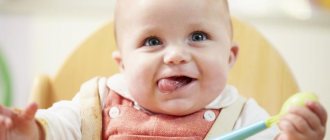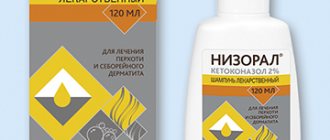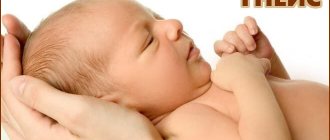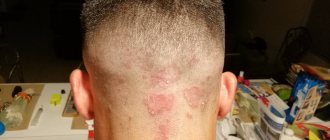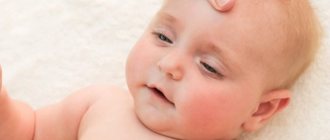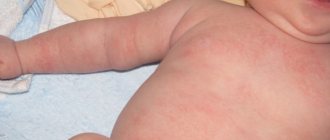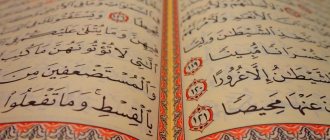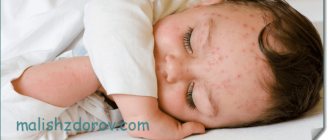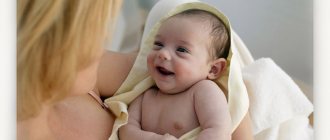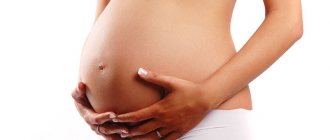Unpleasant yellowish crusts interfere with the growth of soft and fluffy hairs of a newborn baby - what is it, how to deal with it and is there any medical treatment? There is no need to panic in any case; you need to try to figure it out, understand the cause and eliminate unpleasant formations in an effective, proven way.
Dirty-gray, yellowish or white crusts that form on a child’s head have several names - gneiss, lep, milky, seborrheic crusts and even “cradle cap”. Formations of varying degrees of intensity appear in most newborn babies in the first months of life.
Crusts on the head - the reason for the appearance
The cause of seborrheic dermatitis in newborns has not been fully established. But doctors note the connection between the appearance of crusts on the head of a newborn and diseases of the gastrointestinal tract in the mother during pregnancy, deficiency of vitamins, unsaturated fatty acids and abuse during pregnancy of products containing so-called obligate allergens (such as chocolate, honey, nuts, citrus fruits and etc.), that is, substances that most often cause food allergies. Another factor in the appearance of crusts in a child is the immaturity of his sweat and sebaceous glands: the baby’s skin is too delicate, the increased work of the sebaceous glands leads to the formation of white-yellowish scales.
Sometimes it happens that gneiss appears suddenly as a reaction to an allergen - crusts can appear on the top of the head in children who are predisposed to allergies due to treatment with antibiotics or from the abuse of sweets. But in most cases, the number of scales increases gradually.
The main reason for the development of seborrheic dermatitis in adolescents and adults is the intensive proliferation of a yeast-like fungus that is present on the skin of most people. And in the presence of provoking factors (increased production of sebaceous secretions by the skin, decreased local or general immunity, poor nutrition, vitamin deficiency, stressful situations, etc.), the proliferation of the fungus gets out of control and leads to the development of this disease.
With a mild form of seborrheic dermatitis (when crusts are visible only on the top of the head, behind the ear, sometimes on the face), the general condition of the child is not affected.
In the moderate form of seborrheic dermatitis, redness and peeling spread to the face, neck, ears, torso and limbs. And the scales on the head resemble potato chips. The child becomes restless, regurgitation may occur, and bowel movements (diarrhea) become more frequent.
In severe cases, the abundance of fatty scales on the head extends to 2/3 of its area and creates the impression of a continuous coating or crust, which is also called “baby’s cap.” A secondary infection occurs, which causes weeping and suppuration. The child becomes lethargic or restless, eats poorly and gains weight poorly.
What it is?
Dark brown or yellow crusts appear under the hair of most babies. Doctors call this seborrheic dermatitis and consider the condition not dangerous for the baby. There is still debate about the reasons for the development. It is well established that the following factors provoke the appearance of gneiss:
Normally, the condition stabilizes on its own as the baby grows and develops. If gneiss persists for a long time or occurs repeatedly, the possibility of a hidden allergy is suspected.
How to remove crusts from a child's head?
To prevent yellowish crusts on the head from spoiling the appearance of your beloved baby and preventing normal hair growth, it is necessary to comb them properly.
Do not rip off or scratch the scales under any circumstances . Firstly, it hurts the child, and secondly, it is not unsafe - you risk injuring the very delicate baby skin. When removing scales stuck together from fat, areas of inflammation and redness are found on the skin, which can become infected.
To remove crusts from a child’s head, it is important to follow a certain sequence:
- Prepare any oil (baby, Vaseline, burdock or olive), a comb with soft bristles (some mothers manage to remove crusts using a used toothbrush with soft bristles), a cotton cap.
- An hour and a half before bathing, rub any slightly warmed oil into the baby’s head and put on a cap. If you don’t have that much time, then do it at least 15-20 minutes before swimming.
- When bathing, carefully wash the baby's head with shampoo and rinse off the soaked scales.
- Immediately after bathing, very carefully comb the remaining crusts from the baby's head with a blunt-tooth comb from front to back, and then complete the procedure by combing with a soft brush. Particular attention should be paid to the fontanel area - this is the most vulnerable spot on the baby’s head. The skin on the fontanel is in greater need of cleanliness and ventilation, so it is necessary to remove the crust from this area, but very carefully. During combing, many crusts are removed along with the hairs.
- It is most likely not possible to completely get rid of the crusts in one procedure, so repeat the procedure once a week during subsequent bathing until they disappear completely.
If gneiss forms again, then most likely this is a sign of diathesis (exudative-catarrhal) or another allergic nature. In this case, it is necessary to consult an allergist, dermatologist and take a blood test (clinical, biochemical) and urine (general).
Traditional methods
Traditional medicine has also succeeded well in treating scalp diseases. In addition, such methods have stood the test of time and have proven their effectiveness over many generations.
A decoction of oak bark will provide high-quality treatment aimed at getting rid of seborrheic dermatitis.
To prepare the infusion, you need to take a tablespoon of crushed bark , pour in 0.4 liters of boiling water and keep in a water bath for 5 minutes.
Before use, add a teaspoon of honey. Treatment with this decoction is carried out by rubbing into the scalp up to three times a day.
A very easy to use, but no less effective way is to rub kombucha into the scalp . It is enough to do this procedure for a month to completely get rid of crusty dandruff.
A medicinal ointment that contains a tablespoon of crushed golden mustache leaves and olive oil, a tube of baby cream, and a teaspoon of valerian tincture will also be effective. This ointment should be used to treat lesions with seborrheic dermatitis. It has a complex therapeutic effect.
Important! Before using any method, it is necessary to test for allergic reactions!
Check out on our website the traditional methods of treatment: egg, salt, soda, tar soap, laundry soap, apple cider vinegar; with recipes for medicinal masks for oily hair, against dandruff and itching, as well as medicinal oils - castor, tea tree, burdock and treatment with herbs, such as nettle.
Treatment of seborrheic dermatitis
Only severe forms of seborrheic dermatitis require drug treatment (antibiotics for infection, antihistamines to reduce itching); in other cases, gneiss does not cause any harm or concern to the baby and does not require specific treatment. Over time, when the child’s body gets stronger, the crusts will stop appearing on their own, and those scales that are already there or that appear after some time must be removed.
The main treatment for children with seborrheic dermatitis is local therapy using disinfectants. If you are not allergic to medicinal herbs, it is recommended to wash your hair using decoctions of chamomile, sage and calendula. If the areas begin to get wet (especially in the folds of the skin), then to disinfect and prevent the addition of a secondary infection, they are lubricated with antiseptic agents: a 1% solution of brilliant green (brilliant green) or methylene blue, decoctions of chamomile, plantain, marshmallow root.
For seborrheic dermatitis in breastfed children, you should pay attention to the mother's diet, exclude allergenic foods and limit or completely eliminate industrially canned products.
For older children, a balanced diet is recommended, excluding sweets, carbohydrates and fatty foods. Including vegetables and fruits and rosehip decoctions in the diet helps to cope with the acute period of the disease in a minimum period of time. Vitamin complexes containing vitamins A and E, that is, those substances that are involved in the construction of skin cells, are well suited for the treatment of seborrhea. Medicinal shampoos with an antifungal effect (Nizoral, Keto Plus, Perhotal, etc.) and antifungal ointments and creams can be used.
A fairly common problem is crusts on the head of a 2-year-old child. The first thing to do in such a situation is to eliminate panic. This phenomenon in children under three years of age is not dangerous, but occurs quite often.
If crusts are on the baby's head, then this is normal. They are also called generic.
A common cause of the appearance of yellowish crusts on the scalp is the overactive work of the sebaceous glands. That is, discharge cannot be easily removed from a newborn during normal bathing. The liquid dries out and a layer—a crust—accumulates. Naturally, they look ugly in appearance, but you shouldn’t be too upset, because the baby doesn’t feel any discomfort.
In the language of pediatricians, yellow crusts are called seborrheic dermatitis. If this phenomenon is treated correctly and competently, it will disappear without a trace over time. As a rule, this takes from 1 to 3 months.
A fairly common problem is crusts on the head of a 2-year-old child. The first thing to do in such a situation is to eliminate panic. This phenomenon in children under three years of age is not dangerous, but occurs quite often.
If crusts are on the baby's head, then this is normal. They are also called generic.
A common cause of the appearance of yellowish crusts on the scalp is the overactive work of the sebaceous glands. That is, discharge cannot be easily removed from a newborn during normal bathing. The liquid dries out and a layer—a crust—accumulates. Naturally, they look ugly in appearance, but you shouldn’t be too upset, because the baby doesn’t feel any discomfort.
In the language of pediatricians, yellow crusts are called seborrheic dermatitis. If this phenomenon is treated correctly and competently, it will disappear without a trace over time. As a rule, this takes from 1 to 3 months.
Causes of crust formation
Seborrheic dermatitis was known back in the 19th century. Then this disease was called xerosis. Active development of the sebaceous glands has been described. Seborrhea as an ailment is most typical for newborns, but there are cases when children under 14 years of age also suffer from this form of dermatitis.
To this day, there is no scientifically proven cause of the disease.
Among the factors influencing the appearance of crusts on the head are:
- changes in hormonal levels, its sharp imbalance;
- disruption of the formation and development of the sebaceous glands (causes include the presence of infections or other diseases during pregnancy);
- genetic predisposition, that is, susceptibility to allergens can be transmitted from parents;
- insufficient content of vitamin B in the body, namely biotin (it is a control lever for metabolism);
- Older children (from two years old) may suffer from seborrheic dermatitis due to dysfunction of the thyroid gland or pathologies of the nervous system.
According to statistics, the most frequent cases of crusts appearing are observed in the cool season.
Clinical manifestations of seborrheic dermatitis
Most often, crusts may appear on the scalp in infants (2 weeks - 4 months of age) or children under 14 years of age. They cover the scalp, usually unevenly. Sometimes, layered formations may occur. Scales develop as a result of mass reproduction of the fungus.
As for the localization of the lesion, this is the scalp, eyebrows, sometimes the ears, groin area, wings of the nose or the armpits of the child. Therefore, it is clear that it depends on the location of the sebaceous glands.
As a rule, seborrheic crusts do not cause severe discomfort in the baby. However, if there is a place for a pathogenic infection, then the consequences cannot be avoided. If it penetrates, the skin will become inflamed, and there will be an increase in temperature in the area of redness.
If you notice symptoms in your baby, you should immediately consult a doctor and begin an examination.
Diagnosis of pathology
If there is a suspicion of seborrheic dermatitis, a dermatologist will first examine the affected areas of the skin. With typical symptoms, the diagnosis is usually confirmed. However, dandruff and flakes can also cause other skin conditions:
- psoriasis;
- eczema;
- herpes zoster or pityriasis versicolor.
To distinguish the disease, a dermatologist may take a scraping of dandruff and, if in doubt, a deeper sample of skin tissue for histological examination.
Classification of seborrheic dermatitis in children
According to clinical manifestations, seborrhea is divided into various forms:
- fat;
- dry;
- combined;
- physiological.
The appearance of the oily form is caused by overactivity of the sebaceous glands. As a result, large scales begin to form, which stick together into a durable layer. Increased oiliness of the skin becomes a provocateur for the activity of pathogenic microbes. The development of this type of dermatitis in children during puberty contributes to the appearance of acne and pimples.
If the disease is caused by a dry form of seborrhea, then this happens as a result of a lack of activity of the sebaceous glands. This variety is typical for babies in the first year of life. The emerging scales form a film on the head, but they are quite easily separated from the surface of the skin. The crusts range in color from yellow-whitish to white-grayish. At this time, the baby's hair becomes thinner, breaks, and may fall out. The appearance of bald spots on a child's head is a common occurrence with seborrheic dermatitis.
In the dry form, pinkish-reddish spots may appear.
The combined type of seborrhea is the result of a fusion of symptoms of several types of illness. Clinically, the disease may appear as dry scales on the child’s head, and an oily surface on the face, behind the ears.
The physiological form of seborrheic crusts is characterized by acne and other skin lesions. This is due to the fact that there is a restructuring of the usual functioning of the sebaceous glands.
Treatment of the disease
In many cases, the manifestations of seborrheic dermatitis go away without consequences. However, some of them may carry symptoms of quite serious diseases. Examples are exudative diathesis, atopic dermatitis or psoriasis.
Seborrheic lesions, coupled with insufficient body weight of the baby according to age, are a symptom of the manifestation and development of Leiner's erythroderma.
Thanks to the fact that the mother will quickly notice the changes and also consult a doctor, it will be possible to make the correct diagnosis and carry out competent treatment.
The primary solution is to convince yourself that the child has seborrheic dermatitis. You should carefully monitor the baby's scalp during water procedures and using the toilet. When combing scales, it is important not to injure the skin. Thus, damage can lead to the proliferation of pathogenic infections. Sometimes redness on the skin and increased discharge occur.
Consultation and recommendations of a pediatrician will be a reasonable decision.
During complex treatment, one of the most important actions is thorough washing of the hair and scalp. For this, only specialized and completely hypoallergenic shampoo or detergent is used. Seborrheic crusts themselves should be removed from the skin carefully. You can’t just pick and tear off the scales, as this can cause damage to the epithelium. It is worth understanding that the infection penetrates into the affected areas quickly, and treatment will not be easy.
First, you should take sterile Vaseline or other cosmetic oil and apply it to the scalp. For better absorption and softening of the crusts, put on a cap for 15-20 minutes. After which you should thoroughly wash your hair using a special shampoo. You should comb your hair with a soft brush. With these simple steps you can get rid of crusts on your baby’s head without damage.
It is important to understand that seborrheic dermatitis can occur either without a trace or with consequences. The disease can progress. Therefore, it is important to thoroughly rinse the child’s head. There is no need to be afraid that you can easily harm your hair and skin. This is wrong. Insufficient combing and shampooing may not get rid of the crusts. It is important to clear the ducts of sebaceous gland secretions.
Most children suffering from seborrheic dermatitis between the ages of 2 weeks and 4 months completely get rid of the pathology by the beginning of the 5th month of life.
Treatment with pharmaceuticals
How to cure dandruff in the form of a crust on the head? In pharmacies you can find many products that are aimed at helping in the treatment of this disease at affordable prices. Among them are drugs for treating the problem from the inside, as well as for local use.
Particularly popular are pharmacological preparations that include salicylic acid. Its effectiveness in the treatment of seborrheic dermatitis is due to its anti-inflammatory properties and the presence of a disinfecting effect. The most well-known remedy is salicylic ointment .
The action of the drug is dictated by its remarkable property of actively penetrating under the dandruff layer and reducing it. It is recommended to apply this drug at night.
Patients noted an active therapeutic effect , combined with an affordable price.
However, salicylic ointment, like any drug, is not without its drawbacks. Among the population treated with this drug, allergic reactions were observed in the form of itching and rashes, and in addition, there was an increase in body temperature and the presence of pain.
Additionally, find out about homemade masks for hair growth: with vitamins B6 and B12, with nicotinic acid, from coffee grounds, with vodka, with and without dimexide and sea buckthorn oil, with mustard, with mustard and burdock oil (sugar, honey), with aloe, cognac, salt, beer, gelatin, henna, ginger, bread, kefir, yeast, cinnamon, with honey, with honey and cinnamon (egg), separately with egg, onion, as well as for different types of hair and masks on night.
A drug called Naftaderm actively fights the symptoms of seborrheic dermatitis and psoriasis . It has an effect that is aimed at accelerating tissue regeneration. In addition, the drug has anti-inflammatory, antipruritic and disinfectant properties.
Naftaderm must be carefully applied to the problem twice a day for 4 weeks . Patients treated with this drug noted its high effectiveness, but at the same time were not very happy with the cost (the price of the drug is about 500 rubles). A certain category of patients noted the occurrence of dry skin.
You shouldn’t ignore the series of cosmetics called “Squafan” . The line of these cosmetics includes lotion and shampoo against severe dandruff.
The preparations contain components whose action is aimed at getting rid of itching sensations and reducing the proliferation of dead epidermal cells.
And most importantly, this series of drugs is aimed at reducing the population of the main factor in the development of seborrheic dermatitis - yeast fungus .
For most patients, the shampoo and lotion provided good results, but some people experienced the opposite effect. In addition, the shampoo and lotion turned out to be quite expensive drugs.
A topical drug for solving problems with diseases of the scalp will be Keto Plus shampoo . It contains ketoconazole, which is famous for its excellent antifungal effect.
Patients cope with the assigned tasks perfectly and, in addition, the effect of use lasts much longer than from other similar drugs.
But for a certain category of the population, the price for such treatment seemed high (the price of shampoo is 300-400 rubles). In addition, some people who underwent treatment experienced itching , irritation, and increased dryness or oiliness of their hair. In exceptional cases, a change in the color of the curls was noticed.
The favorite among pharmaceutical products is, undoubtedly, the Sulsena . Perhaps these remedies are the most effective in the treatment of seborrheic dermatitis. The shampoo of this brand is aimed at the process of normalizing the functions of the sebaceous glands, suppressing the growth of fungi and eliminating their further reproduction.
In addition, Sulsena has a good exfoliating effect and improves the regeneration process of skin cells. The big advantage of this drug is its rapid action.
After all, the result of the shampoo is noticeable after 3-4 uses! As a result, individual allergic reactions to the ingredients of the drug are possible.
To achieve the maximum effect, it is worth adding Sulsena medicinal paste to the shampoo treatment, the concentration of the active substance in which is 2%. It effectively fights both the manifestations of seborrheic dermatitis and psoriasis.
Has a remarkable effect against the increase in excessive sebum production. In addition to all the effects that shampoo has, the medicinal paste helps accelerate hair growth and also effectively strengthens curls. As a result, the hair is not only cured from the inside, but its appearance is also significantly improved.
Sulsena paste is not without minor drawbacks , which include allergic reactions, irritation of the scalp and possible change in hair color. To prevent relapse of the disease, it is necessary to use Sulsena prophylactic paste with a concentration of the active substance of 1%.
Oral medications for the treatment of seborrheic dermatitis are tablets that are prescribed depending on the factor that caused the disease. Typically, such drugs are taken in combination with the use of medicinal products for external use.
Attention! It is not recommended to take oral medications without consulting and prescribing a specialist!
Prevention
There is no point in relaxing after the disease has subsided. Parents must clearly understand that prevention is better than cure. Therefore, in the arsenal of baby care products there should be a place for antiseborrheic shampoo. Using this remedy, you can reduce the risk of inflammation of the skin and minimize the activity of yeast-like fungi.
After taking a bath, be sure to apply a cream with a drying effect to your baby’s hair. Head monitoring is a must. If discomfort, allergic reactions, itching, peeling and other signs occur, you should immediately stop using the cream. A pediatrician will be able to recommend alternative products for caring for your child’s skin and hair.
For the purpose of prevention, it is worth not only strictly observing hygiene rules, but also eating right, since the appearance of dermatitis can be caused by allergies. It is better to exclude from the baby’s diet foods that can provoke it. It is important that the child’s (or nursing mother’s) diet includes foods high in vitamins such as A and C. Daily consumption of B elements is also required.
The doctor will provide recommendations on organizing the daily diet of the baby and mother. A deficiency, as well as an excess, of vitamins and minerals can negatively affect the course of the disease and its treatment.
Timely detection of the disease, contacting a specialist and competent therapy will be the key to a quick recovery and avoiding relapse.
Unpleasant yellowish crusts interfere with the growth of soft and fluffy hairs of a newborn baby - what is it, how to deal with it and is there any medical treatment? There is no need to panic in any case; you need to try to figure it out, understand the cause and eliminate unpleasant formations in an effective, proven way.
Is gneiss a disease?
There is no need to blame a young mother for careless care of her baby. Gneiss is a physiological phenomenon, the causes of which lie in the imperfect functioning of the sebaceous and sweat glands, or more precisely, in their disharmonious work.
It may not go away for a long time if the child’s scalp is not properly cared for and there is a tendency to allergic reactions.
Typically, gneiss on the scalp is most noticeable on the crown, in the fontanelle area, and may even be on the baby’s forehead and eyebrows. The child’s mother, frightened by such a sight and the belief of some people that her child’s hair will not grow, can, of course, immediately go for a consultation with a pediatrician. However, before visiting a doctor, you can try to figure out the causes of the nasty lep yourself.
Looking for reasons
1. For excessive fear of drafts and hypothermia, parents put a hat on their baby, even at home. This leads to even more sweating of the head and the appearance of more and more milky crusts.
2. The baby’s delicate skin is quite vulnerable. Cosmetics containing fragrances and dyes can also provoke various skin reactions. It is necessary to avoid cosmetics with bright colors and strong odors. And of course, never use shampoos for adults.
3. Daily water procedures with washing your hair will most likely lead to dry scalp. As a result, the work of the sebaceous glands will intensify, and the number of yellow crusts will only increase.
4. Strange as it may sound, the cause of the appearance of gneiss may also be the introduction of complementary foods. Mostly, such reactions occur in children prone to allergies.
Having analyzed the correctness of caring for the baby, and having understood your mistakes, it is still worth starting to rid the small head of unnecessary layers. You shouldn’t wait for the gneiss on your head and eyebrows to go away on its own. Lack of proper scalp care can lead to prolonged seborrhea and the child’s crusts will remain until the age of 4 or even 7 years and will require consultation with a dermatologist. With proper care, the dark crusts gradually disappear by the second year of the baby’s life.
You should not use drastic methods of removing the crust, trying to pick and rip off the scales using nails or other objects. This can injure the delicate skin, causing a lot of anxiety for the baby.
Processing gneiss at home
Doctors do not advise parents to peel off the scabs with their fingers or a washcloth. It is so easy to injure delicate baby skin, and open abrasions and cracks can become infected. This procedure is painful and dangerous for the child. Instead, here are some simple tips for caring for skin affected by seborrheic dermatitis:
To process gneiss you will need oil and a comb or brush with rare, soft teeth.
Medicines for the treatment of gneiss (antibiotics and antiallergic) have a strong effect and are prescribed only in cases of infection.
Typically, regular brushing and oil treatment will eliminate the appearance of dermatitis.
The appearance of gneiss in children under 2-3 months is recognized by doctors as a normal variant. As a rule, parents can cope with the problem on their own if they do not injure the child’s delicate skin. In any case, you should consult your pediatrician before starting treatment.
Source
Getting rid of lepa
Milky crusts on a child’s head, how to remove gneiss at home? A more acceptable and most correct way to get rid of unpleasant formations is simple daily procedures. To perform them, you will need baby oil, which can be replaced with olive oil, Vaseline or even refined oil, but special oil for babies is much easier to wash off.
You will need a comb and brush. The comb must have blunt teeth so as not to injure delicate skin. A brush with synthetic bristles is unsuitable; you only need to choose combs with natural, soft bristles.
For children's cosmetics, you will need shampoo or gel-cream suitable for daily washing of the head and body. It is advisable to choose products without a strong odor, bright color, with plant-based detergents that do not contain soap. The list of ingredients (on the product label) should not contain dyes or preservatives, only natural ingredients: herbal extracts, oils and water emulsions.
So, having prepared everything you need, you can begin the procedures for cleaning your head from mold. An hour, or at least 20-30 minutes before bathing, you need to thoroughly lubricate the little one's head with warm baby oil (olive, vegetable, vaseline). To prevent the oil from spreading and getting into the child’s eyes, you need to wear a cap, which additionally acts as a warming compress. Under the influence of oil, the scales soften, as a result, it will be much easier to remove the plaque. Before washing your hair, you can carefully remove exfoliated scales with a cotton swab.
While bathing, a little shampoo foams in your hands and is applied to the baby’s head, after which it is carefully washed off, avoiding foam and water getting into the baby’s eyes and ears. During daily water procedures without using shampoo, areas where crusts have accumulated can be gently rubbed with a sponge, without being particularly zealous.
After bathing, all that remains is to comb out the leopard with a comb, and then go through it with a soft brush. Gentle, careful movements when combing with a brush will not only help remove loose crusts, but also stimulate hair growth, at the same time calming the child. For daily morning procedures, it is also necessary to use a comb and brush.
A few simple rules and daily care of a child’s scalp can do wonders without any medications, the help of which should be sought only on the recommendation of a doctor.
Let’s summarize how to treat a mold on a child’s head.
1. Do not wrap the baby, free the head from the cap indoors, allowing the skin to breathe.
2. As long as the baby has no hairs on his head, but only fluff, cosmetic products do not need to be used. In the future, you should not overuse shampoo and other products; you should wash your hair no more than twice a week. Best option once.
3. Be careful when selecting shampoo and other hair care cosmetics for your child. Excluding low-quality products containing preservatives and dyes, with expired expiration dates.
4. Comb the baby’s hair and do not forget to carry out activities that help exfoliate the hair.
If systematic procedures for removing gneiss over a long period of time do not have a positive effect, and there are more crusts, you should consult a dermatologist. With proper and timely care, seborrheic crust in children goes away without any kind of complications, without causing any particular inconvenience to either the baby or his mother. Thick curls and a clean baby's head will be a worthy reward for a caring mother.
Almost every second child has crusts on the head, so the problem has long been known to everyone and does not make mothers panic. But this does not make the questions any less. First of all, parents are interested in how to remove them, and then they begin to find out the reasons and think about prevention. Let's try to figure out the problem.
Gneiss in infants
The hairstyle of babies in their first year of life undergoes a number of changes. As a rule, a child is born hairy. Then, fluff-like hairs roll out, especially in places where the head comes into contact with the mother's hand during feeding. Hair may change color and grows very slowly.
You can also find yellowish spots on the baby’s head that are not very pleasant to look at. In medicine, a similar phenomenon is called gneiss in newborns, lep, seborrheic or milk crusts. We'll talk about them.
What is gneiss
Gneiss occurs in children in the first months of life, and is familiar to almost every family with children. Areas appear on the baby's head that look like accumulations of dandruff, or scales with a color range from yellow to grayish. Islands of gneiss can be either small or grow, covering the head like a cap. Sometimes the crusts spread to other parts of the body: behind the ears, on the neck, eyebrows.
Gneiss usually appears in the first month of life, and some children are already born as such. But by the age of 6 months, in almost all cases, not a trace remains of the crusts.
Gneiss in a newborn is not a disease, it does not cause pain or suffering to the baby, for the most part it does not require special treatment and can be removed simply, but not in one go. Where does it come from?
Causes
There is an opinion that the baby's scabs appear due to breastfeeding, and when the mother stops breastfeeding, they disappear. That is why such crusts are called milk crusts. But this is a myth. There is no connection between gneiss and breastfeeding.
Although gneiss is not a disease, it looks unaesthetic, so parents try to get rid of it
Seborrheic crusts are called not because they indicate a disease, but because the forming scales are similar in appearance to those that form with seborrheic dermatitis.
The main cause of gneiss is hyperfunction of the sebaceous glands. In a baby, many organs and systems operate in “tuning” mode. Firstly, the hormonal background fails, which changes somewhat after birth. Secondly, the sweat and sebaceous glands have not yet learned to cope with their tasks, so scales form on the head as a result of excess sebum secretion. There are other factors that can aggravate this condition.
What enhances the formation of gneiss?
We recommend reading: Why the skin of newborns peels
- Tendency to allergies. When a child is prone to diathesis and other manifestations of allergies, his immunity is weaker than usual. Therefore, crusts on the head may not go away for a long time.
- Overheat. Imperfect thermoregulation is not able to withstand overheating of the skin, and the heat exchange process is more difficult. It is especially bad when a child wears a cap for 24 hours in the summer. There is no need to cover the baby's head if you are at home or outside, it is hot, accompanied by a slight breeze.
- Frequent washing. If you are a supporter of washing your baby’s hair every day with all kinds of shampoos, then know that in this way you are more likely to dry out the baby’s delicate skin, which only mobilizes the work of the sebaceous glands, and the crusts grow more intensely.
- Unsuitable hygiene products. Not all shampoos and foams for washing hair are suitable for your baby, even if they are marked “from birth” or “hypoallergenic”. And remember, even if the product is suitable, the baby’s head is washed once, maximum twice a week.
How to get rid of crusts
What happens if the baby's gneiss is not touched? Actually, it's okay. The time will come, and the crusts will disappear on their own (unless, of course, there are allergic problems). But few parents are ready to look at them every day. Purely for aesthetic purposes, most people strive to get rid of gneiss as quickly as possible. Well, it is quite possible to speed up the process, but you need to do it correctly.
Combing correctly
In order to comb out the leopard, purchase a special comb with natural bristles and a plastic comb with blunt, fine teeth from the pharmacy. On the day when you plan to bathe and wash your hair, the scalp is lubricated with oil 40-60 minutes before water procedures, and a cotton cap is put on.
Pharmacies sell special combs for combing out hair.
Immediately before bathing, the cap is removed and the scalp is massaged using fingertips or a comb with natural bristles.
Pharmaceutical companies have developed a lot of cosmetic products aimed at combating gneiss.
It is forbidden to pick out crusts with your nails, especially “dry”. Such manipulations are fraught with the formation of wounds with possible infection. All this causes discomfort to the baby.
Let's start with water procedures. Lather your hair with baby shampoo, massage again, and then carefully rinse. We blot the hair with a towel and begin to comb it first with a comb and then with a brush. To save money, the comb can be replaced with gauze folded in several layers.
There are special creams for seborrheic crusts, for example, Mustela Stelaker or cream from the Uriage series. Their action is approximately the same. At night, the cream is applied to the scabs, they soften, and in the morning the hair is washed with shampoo and combed. Manufacturers promise to get rid of gneiss in one day. In practice, softening occurs, but several sessions are necessary.
You should not try to get rid of gneiss in one go. All actions aimed at eliminating them must be carried out delicately, slowly, avoiding injury to the delicate baby skin.
Preventive measures
What else will help get rid of milk crusts faster? Here are some recommendations:
- Give your skin a chance to breathe. Spending some time naked is very beneficial. Do not overuse the wearing of caps and caps unless necessary.
- Reduce the room temperature. Everyone knows that to maintain health, the optimal temperature in a children's room should be close to 20 OC, and humidity levels should be kept at approximately 60-70%. Modern devices such as air conditioners and humidifiers can become your faithful assistants if used correctly.
- For children - children's cosmetics. Don't try to save money on baby shampoo. Subsequently, you can spend a lot more money on treating allergic diseases.
If there is no direct sunlight during a walk on a summer morning, do you need to wear a cap every time?
When you need a doctor's help
If the gneiss stubbornly does not go away, look for the reason. It could be a fungal infection or atopic dermatitis. Review your diet if you are breastfeeding.
You should definitely consult a doctor if you have the following signs:
- within a week of trying to get rid of gneiss there are no changes;
- the child tries to scratch the scabs and becomes irritable;
- scales become wet;
- crusts grow;
- the scales peel off and spread throughout the body.
As you can see, gneiss in newborns is not as terrible as it seems at first. It is associated with the physiological characteristics of the infant period and passes without a trace over time. But sometimes you need to consult a doctor so as not to miss a disease that can masquerade as milk crusts.
mladeni.ru
Causes of crust formation
The main reason for crusts is quite simple. The thing is that newborns have very delicate skin, which in itself predisposes to the appearance of any skin disorders. And now, to the low protective properties of the skin, add a violation of thermoregulation or water balance of tissues, and the conditions for the occurrence of such a problem become even more intense.
But all this only creates favorable conditions, and crusts appear due to the peculiarities of the sebaceous and sweat glands. In infants, the former work too actively, while the latter are still too densely located, and their number is much greater than in older children or adults. But they will begin to work normally only by the age of 7. As a result, milky (also known as seborrheic) crusts appear.
In a nutshell, the reason lies in the insufficient functioning of the sweat glands and the excessive functioning of the sebaceous glands. All this is inherent in nature and does not depend on any extraneous factors. But there are other causes of seborrheic crusts that are caused by improper care.
- Overheating, as it leads to increased sweating.
- Shampoo. This means if it is chosen incorrectly. Ideally, its composition should be as close to natural as possible and not contain a variety of fragrances, dyes and other chemicals.
- Frequent hair washing, which washes away the already thin protective layer and causes dry skin. Which in turn stimulates the work of the sebaceous glands even more, and the child’s crusts only become thicker.
- Allergy. Children with this diagnosis have reduced immunity, which significantly increases the likelihood of milk crusts appearing.
When you need a doctor's help
If the gneiss stubbornly does not go away, look for the reason. It could be a fungal infection or atopic dermatitis. Review your diet if you are breastfeeding.
You should definitely consult a doctor if you have the following signs:
As you can see, gneiss in newborns is not as terrible as it seems at first. It is associated with the physiological characteristics of the infant period and passes without a trace over time. But sometimes you need to consult a doctor so as not to miss a disease that can masquerade as milk crusts.
Source
How to prevent them from appearing
A crust on a child’s head is not a disease, but this does not give us the right to ignore the problem and pretend that everything is fine. Start with allergies, if there are none, then all you need to do to get rid of milk crusts is to follow basic rules of personal hygiene.
- Don't bundle up your child. Please note that this has already been written about more than once, and not only in relation to the appearance of seborrheic crusts. And you especially don’t need to be zealous if you and your baby are indoors and not outdoors. This also includes children's hats; if your child's head constantly sweats, change it to a lighter one.
- Use shampoos only on a natural basis, and even then, no more than twice a week.
- A child's comb should have natural bristles.
- Read and follow the rules for caring for your child's hair.
- As a matter of fact, this alone is enough for the crusts on the newborn’s head to gradually begin to disappear. If this does not happen and they become even more severe, it would be better to seek help from a doctor who will help you find the cause and tell you how to get rid of them.
Prevention of occurrence
Preventive actions, if they do not completely relieve parents of the problem of crusts on the baby’s head, then at least reduce their spread.
- Don't overheat the baby. Always remove your hat in a warm room. At home, it is also not always advisable for even a newborn to wear a hat.
- Maintain air humidity at the desired level.
- Don't be fanatic about washing your baby's hair. You can wash it with detergent 1-2 times a week.
- Carefully select household chemicals for your baby so as not to provoke allergies and dermatitis.
- Use a comb every day, even if there is nothing special to comb. Massage with a natural bristle comb is a good way to prevent crust formation.
Seborrheic crusts on a baby's head are not as serious a problem as mothers might think. If you can’t remove the crusts, you can contact a specialist, but in most cases this problem does not require medical intervention or serious measures.
Reading on the topic of care:
- Why does a child have peeling skin on his head and body?
- Skin care
- Newborn hygiene
source: razvitie-krohi.ru
Date: 5, January, 2015
Author: Alesya
After the baby is born, parents examine every centimeter of his body every day, studying possible changes. Particular attention is focused on the baby's head, where most newborns develop a lep .
These crusts on the head bother many parents. Moms and dads try to rid the baby of this “decoration” as quickly as possible. However, it is very important to take precautions so that the baby does not get hurt.
How to remove milk crusts
Please note that seborrheic crusts cannot be removed with a sharp comb or fingernail. This way you will only hurt your baby and damage the scalp. There are more gentle methods for this.
About an hour before bathing, lubricate the crusts on the child’s head with sterile vegetable oil, Vaseline or salicylic ointment. After this, put a cotton cap on your baby, and after an hour, remove it and gently massage the scalp. To do this, use a comb with natural bristles.
Milk crusts will gradually be washed off when washing your hair. But just remember that you don’t need to lather your hair again and, especially, try to wash it all off in one bath.
After bathing, when the hair begins to dry, it’s time to comb your hair. Gently comb your hair with a wide-toothed comb and then with a soft brush. This will help remove any remaining crusts. But keep in mind that this procedure should not be repeated more than once a week.
